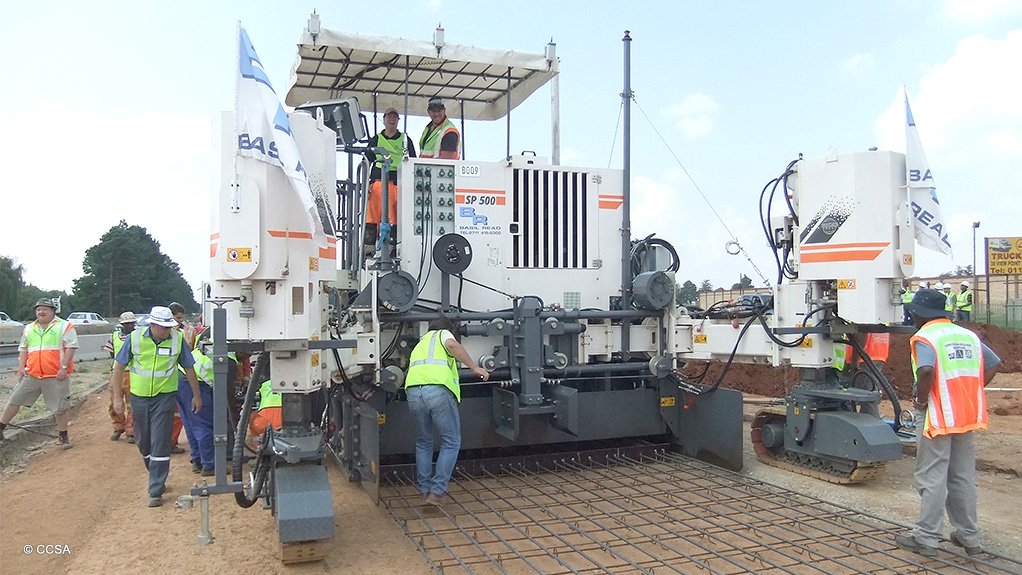Sustainable and resilient concrete roads are critical in supporting sustainable infrastructure development. Building durable roads should be balanced with minimising the carbon emissions throughout the infrastructure’s entire life cycle, which can be achieved using concrete, says industry body Cement and Concrete SA (CCSA) CEO Bryan Perrie.
Concrete roads’ resilience is a particularly important factor to consider for decision- makers in infrastructural development, Perrie says.
He emphasises the difference between sustainability and resilience along with the importance of ensuring both are factored in, considering how roads and the composite materials are produced.
He explains that sustainability deals with known events that can be quantified. However, resilience is the ability to anticipate, prepare for, and adapt to changing conditions. Further, resilience encompasses the ability of infrastructure to withstand, respond to, and recover rapidly after a disruptive event.
“In a changing global climate where extreme weather events are now becoming increasingly frequent, with far higher intensity than in the past, it is impossible to have a sustainable infrastructure without resilience,” he says.
Perrie elaborates that resilient systems can limit the impact of relatively unexpected adverse effects such as storms, floods and droughts, such as those experienced recently in KwaZulu-Natal and the Eastern Cape.
Reducing Emissions
The industry is also navigating how to build more durable concrete structures while minimising the carbon emissions generated in producing and supplying cement and concrete.
Perrie explains that the South African cement industry has already committed to net-zero carbon emissions by 2050.
He notes that, while this commitment focuses on cement’s value chain, it is also important to focus on the concrete value chain. In particular, the whole life cycle – from material production through pavement design, construction, use stage, maintenance and preservation, and end-of-life reuse or recycling – needs to be evaluated to determine the full environmental impact of road infrastructure.
He explains that the full life cycle cost analysis and life cycle assessment can be used to determine the impact of the whole life cycle.
“While some life cycle assessment is done in South Africa, it often does not include the full life cycle assessment, including road-user delay costs during maintenance,” he elaborates.
Perrie acknowledges that, while it is critically important to address climate change and carbon reduction, every road agency, province and municipality is facing budget constraints and often find themselves forced to make decisions based purely on economic factors.
As a result, when life cycle cost analyses are carried out in areas where there is minimal data on concrete roads, the results are frequently heavily biased.
He notes, however, that industry competition can be significantly beneficial in improving the “economic side of sustainability”.
He refers to Massachusetts Institute of Technology Concrete Sustainability Hub, which has stated that US state agencies that have sustained a consistent competitive roads market – using both asphalt and concrete pavements over multiple years – pay lower prices for all paving materials.
“The states with the highest level of competition have unit prices that are 29% lower for concrete and 8% lower for asphalt,” he explains.
Beyond Concrete
While the environmental benefits of concrete roads are considerable, there are numerous easy and minor alterations that can be implemented to improve the environmental impact of concrete, says Perrie.
He explains that these include optimising pavement designs to ensure minimum quantities of materials, reducing concrete’s carbon footprint by using extended cements appropriately, and formulating concrete mix designs with optimised aggregate grading and optimised cement content.
Further, concrete pavements’ inherent stiffness, strength, brightness and durability can significantly reduce carbon emissions during the roads’ usage phase. In particular, using concrete for roads can result in fuel savings, particularly for heavy vehicles which can reduce carbon emissions. Additionally, increased albedo, or reflectivity, resulting from concrete roads, can minimise urban heat islands and can reduce required lighting at night, Perrie comments.
“One of concrete’s unique properties is its ability to act as a carbon dioxide (CO2) ‘sink’ for the planet. As concrete ages, it absorbs CO2 helping to offset the amount produced making cement. Covering concrete pavements with asphalt either at construction or during the use phase prevents this happening.”
Further, he notes that diamond grinding to provide an acceptable riding quality – at construction or to improve it during the usage phase – would increase CO2 absorption. This makes the process a “more sustainable practice”, along with the use of concrete overlays for upgrading existing asphalt roads.
Perrie says it should also be remembered that concrete is 100% recyclable and can be reused on the same site for base material, as aggregate for new concrete and as filler.
He emphasises that concrete provides the most sustainable and resilient choice for pavement systems. Concrete’s long life span provides significant economic value over the long term for taxpayers and end-users, with many environmental benefits.
“Choosing concrete roads for South African infrastructure is ultimately the most responsible choice for both sustainability and resilience,” he concludes.
Edited by: Nadine James
Features Deputy Editor
EMAIL THIS ARTICLE SAVE THIS ARTICLE
ARTICLE ENQUIRY
To subscribe email subscriptions@creamermedia.co.za or click here
To advertise email advertising@creamermedia.co.za or click here













